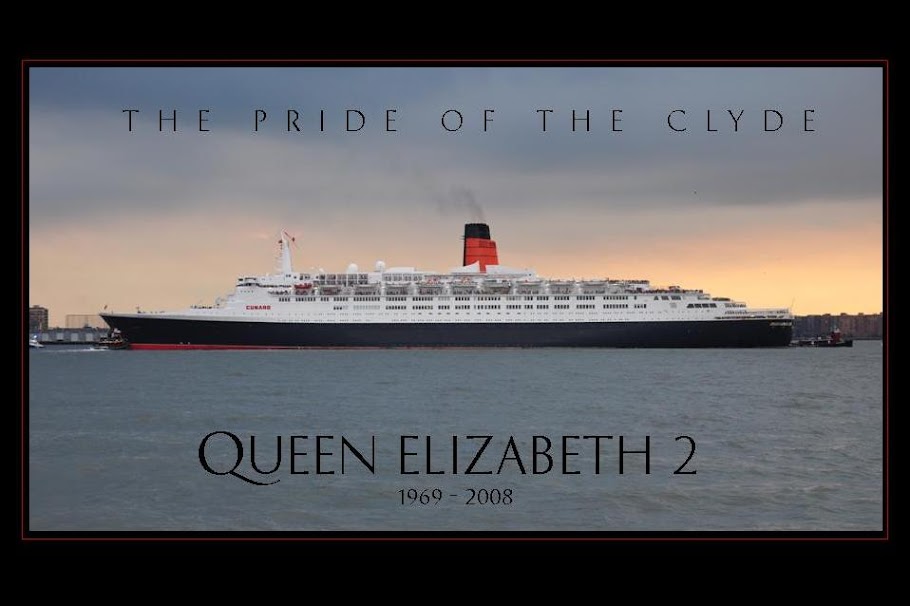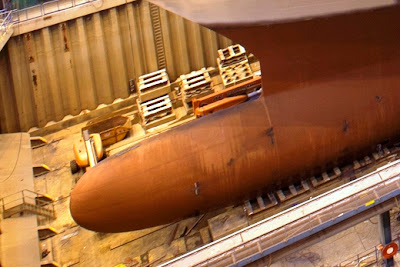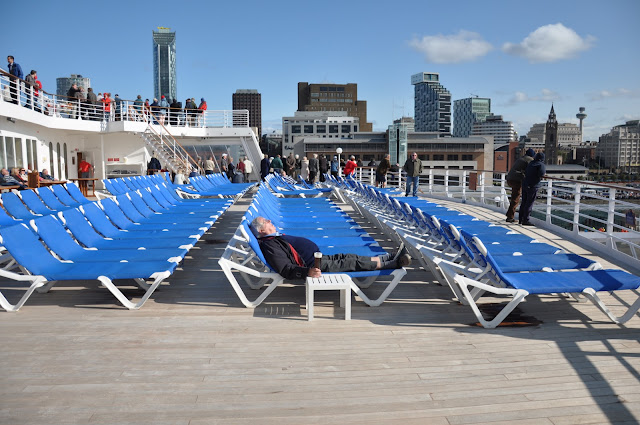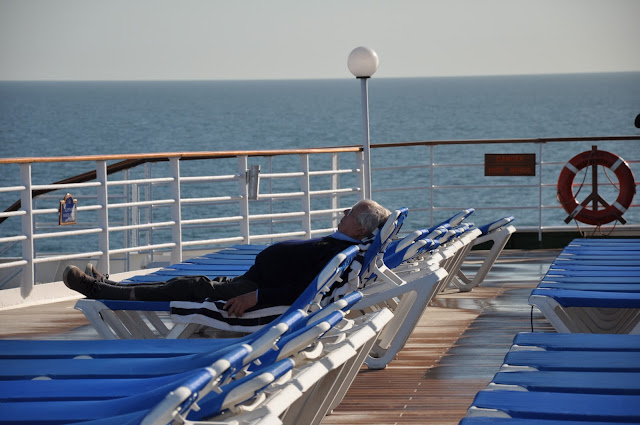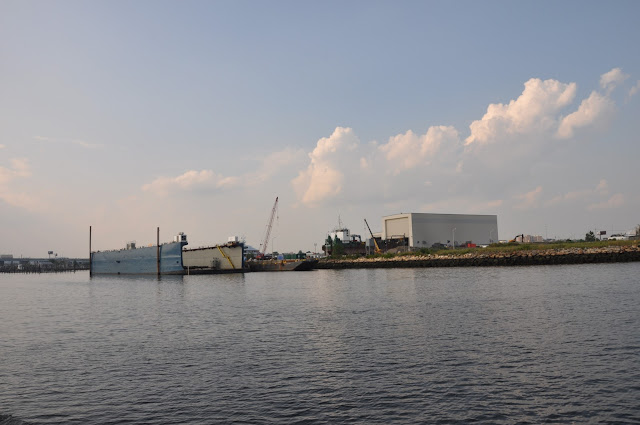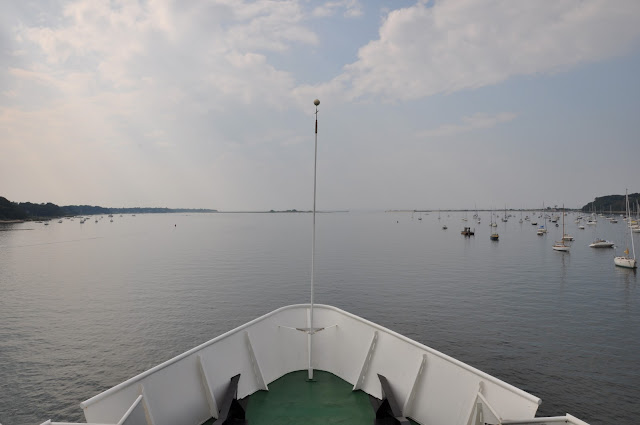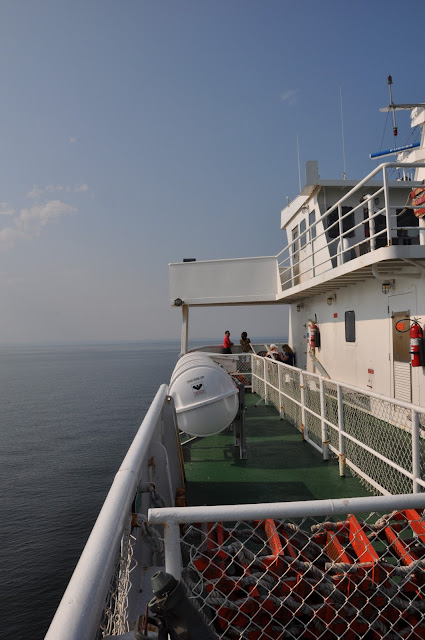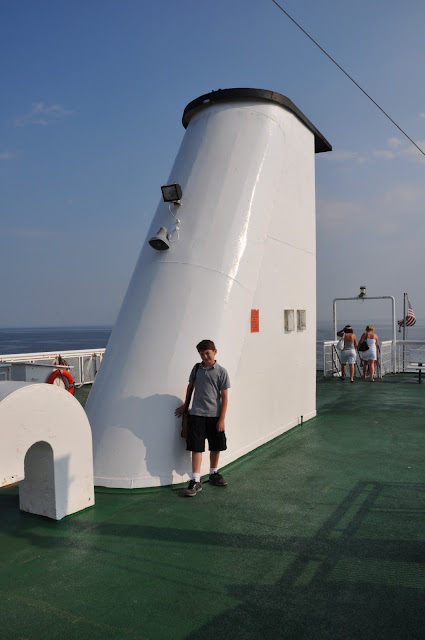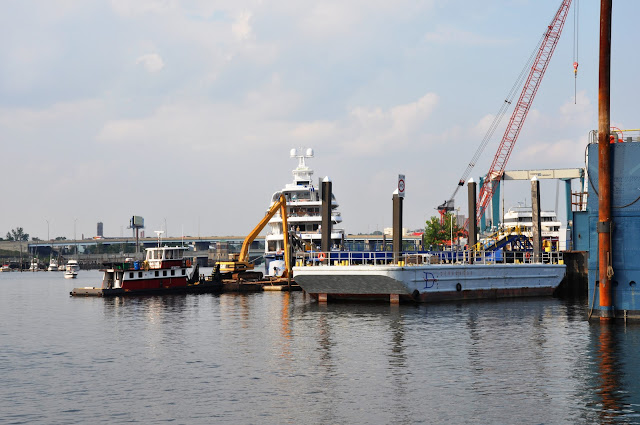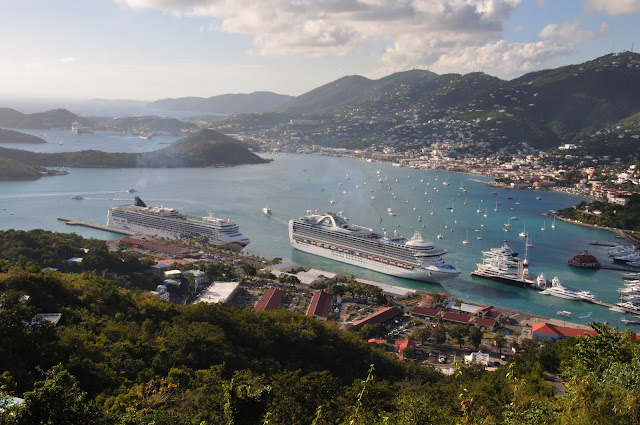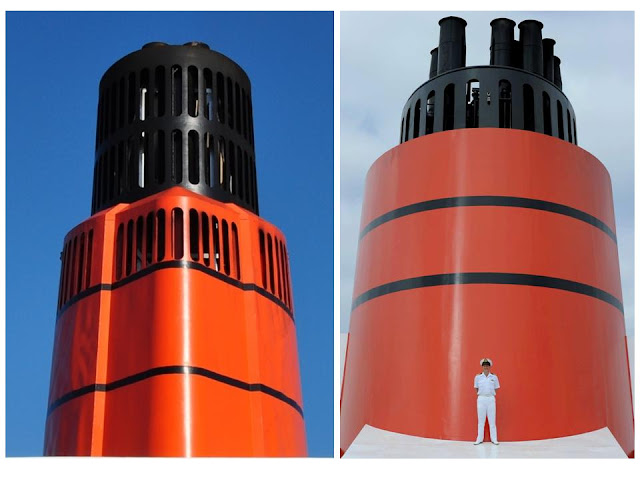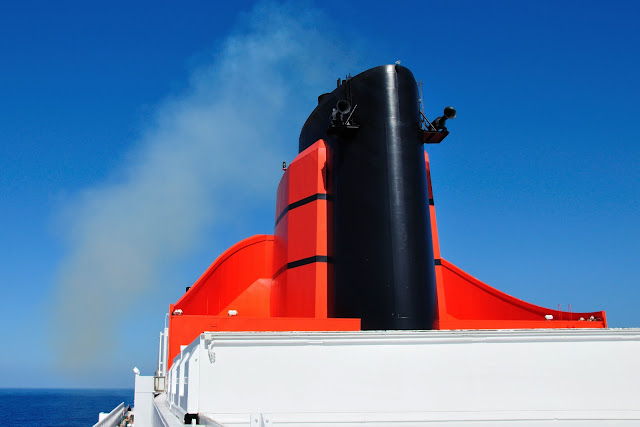What is going on with the hull at the stern, which looks like it's sprouted a ducktail-like appendage? This hull feature clearly has a function since it cannot be said that it was added to enhance the beauty of the ship. Perhaps it was necessary for the hull hydrodynamics for pod propulsion. Wait a minute, this ship does NOT use pods for propulsion. Despite being built at the same yard as Queen Mary 2 and is about the same size, conventional shafts and propellers are used.
So what is going on here? Surely, the yard is not shying away from pod propulsion based solely on the problems that have been experienced on Queen Mary 2 and other Celebrity ships that utilized the Rolls-Royce Mermaid pod design. I'm guessing it has got to be to increase the waterline, increasing hull speed, which, in effect, would allow the ship to use less fuel.
Actually, it seems like we're seeing a trend developing here in cruise ship design and it is not a "pod" thing after all. More evidence here from the stern of the P&O Azura, which sprouted one of these similar appendages. We saw this ship in Barbados while on our Queen Mary 2 Caribbean Calypso cruise this past January. This ship is based on a proven Princess Cruise Lines Grand Class design; you know the ones with the weird handle bar or spoiler attached high above on the stern. Azura, thankfully, was built without it, and this feature is scheduled to be removed from other similar ships in the fleet. Apparently, this feature was just not working for the line. Perhaps those passengers deserted the aptly named Skywalkers nightclub located in the "spoiler" when the seas were anything but smooth. Anyway, I digress. Azura is NOT pod propelled , but has conventional shafts and props with thrusters mounted in the keel area for unassisted tug manuevering. The appendage shown here has slight pockets in it for the propellers, which can be seen in the uneven dark area at the waterline.
Construction photo of the Azura, showing the keel mounted stern thrusters and conventional shaft and prop propulsion. Photo was found on the Cruiselinefans board here

Back to another example of this new trend. Here is the stern of NCL's Jewel, taken from a Circle Line excursion boat on the Hudson in October 2009. Now this ship does have pods; the ABB Azipod design, similar units used on the Vista Class twins Queen Elizabeth and Queen Victoria. The appendage is nicely integrated into the hull here and while not a fan of all the hull graphics, I am not offended by the design, unlike the massive NCL Epic. From this angle, it looks like the appendage will act like similar to trim tabs used on smaller boats. In fact, if you study the hull design of QV/QE and her other sisterships, you can see a less pronounced duck tail appendage in the squared off sterns.
Taken on October 16, 2008, while watching the final departure of QE2 from New York, the Carnival Miracle is one of the first Vista Class type hulls in the vast Carnival fleet. Technically it is classified as a Spirit Class ship and is the precurser to the current Vista Class ships. This ducktail appendage appears less integrated into the hull design as in the latest iterations on the QE/QV twins, HAL's Eurodam and Niew Amsterdam, and the latest from Costa. Carnival is clearly getting alot of their money's worth out of this hull design. On the Miracle, it really does look like this "stern flap" was added after the fact. Look at the corners where there appears to be a pipe guard for additional pod protection.
For Cunard's most current ship, here we have Queen Elizabeth, navigating the locks of the Panama Canal for the first time, courtesy of http://www.wearecunard.com/. The stern flap is now seamlessly integrated into the modified Vista Class hull. From this angle, you can see the added cabins at the stern, resulting in a less rakish profile as compared to the Miracle above.
While this energy saving appendage is subtle here on the Elizabeth, the stern flap appendage appears to have been taken to the extreme on the new Celebrity Solstice class ships. I'll go out on a limb here and say that I rather like the outward appearance of these Celebrity ships, from the distinctive shear profile, sleek bridge wing design, distinctive sloped stern profile, and even the blunt nose bow shape. I could do with less of the dark tinted glass, but I liked the design from the day I saw the artist's renderings posted online.
Delving into the design of this new class of ship for Celebrity, I found a very interesting article explaining all the unique aspects of the ship and the class found here.
Note: all photos of the Solstice here are courtesy of www.meyerwerft.com/
As explained in the above article, an extension of the hull, the extended ducktail, resulted in a sleeker hull and less resistance. Extensive tank testing was done at Marin in the Netherlands, who were used for Queen Mary 2 development, to optimize the hull form.
In addition to the ducktail, there is another feature, not readily apparent underneath the tail called an interceptor. In this case, it was found that a wedge shaped interceptor proved most efficient in decreasing the amount of power required to drive the hull. More information on hull interceptors can be found here.
I've yet to find any really good pictures of this feature, but there is a picture in the Solstice PDF file referenced above that hints at the appendage under the ducktail. You just have to commend the Naval Architects and Celebrity for trying out this new technology. Up close, the tail does look a bit weird to the eye accustomed to more conventional shaped sterns and especially from the air, it really does take on the shape of a ducktail.
Additional measures to reduce fuel consumption included grinding all the hull welds smooth and using the latest state of the art antifouling paint coatings. Cunard has similarily been using this improved coating on its fleet with success. While these contribute to the increased fuel efficiency, the second most readily apparent feature on the new Solstice class is the extended bulbous bow.
Piercing the water in the preceeding bow shot of the Solstice, is a bulbous bow, which appears to take this appendage to the extreme as well. It could very well be the longest bulbous bow fitted on a cruise ship. Unbelievably, it appears to extend to at least the length of the blunt nosed bow. At first I thought this photo below was distorted due to the camera angle, but the above mentioned article explains that the appendage was indeed lengthened for speed.
The Meyer-Werft shipyard design appears different than the extended bulbous bow on Queen Mary 2 in that the cross section is much thinner, less round in appearance.
Queen Mary 2's appendage was lengthened during the design process after tank testing did not produce the hull speed specified by Cunard. As Naval Architect Stephen Payne has mentioned, there are compromised with extending the bulbous bow appendage to increase speed. "Bulb slap" is probably the worse consequence, which occurs when the appendage comes crashing down into heavy seas first, since it is so forward of the bow and sending shudders throughout the ship. QE/QV experience this "wiggle" in heavy seas from what I have read and heard from passengers, but Queen Mary 2 is not immune to this as well. Further discussion on bulbous bows and the eternal cruise ship vs. ocean liner debate can be found here on my favorite forum for discussing all things QE2, http://www.theqe2story.com/.
Queen Victoria's bulbous bow in drydock, courtesy www.wearecunard.com
Who knows how the Solstice ships fare in heavy seas, with their more slender bow-like shape. The interiors of this class of ship are trend setting modern design, much like QE2 was in her time. In the novelty department, the Solstice has a Owens-Corning glass blowing feature and an industry first; real grass on the sports deck. One day, I intend to try out both inovative features first hand.
Jumping on the ducktail bandwagon, Princess Cruises just announded their new Royal Princess cruise ship. At first, I thought that this ship had to have been designed by the Meyer-Werft yard since it resembled the Solstice Class of ships and even included the bridge projection that the yard is famous for on other ships for Aida and NCL. Note: all photos courtesy of Princess Cruises.
The stern flap is readily apparent in this rendering, but this ship is surprisingly going to be built by Fincantieri, which has a long standing relationship with Carnival Corporation. Most recently, Fincantieri has delivered the QV/QE sisters for Cunard for instance and were the builder for the Carnival Splendor, which made the news recently for the dramatic engine room fire and days spent adrift at sea.
As always, you have to follow the money. Shipbuilders and owners are driven financially by the almighty bottom line. Apparently, the cruise ship industry has followed the United States Navy in their quest for fuel savings. I found this paper online, which goes into detail on the "stern flap" technology. If you're interested in what your tax dollars funded, read on. http://www.dt.navy.mil/pao/excerpts%20pages/2001/sternFlap9_01.html
For further technical reading on combining both stern flaps and hull interceptors, take a look at this paper. For further technical reading on stern flaps, take a look here.
All this research has brought back those college memories of brain overload with the sleep robbing Architectural Design Studio and the brain frying mathematics of Naval Architecture classes running concurently.
